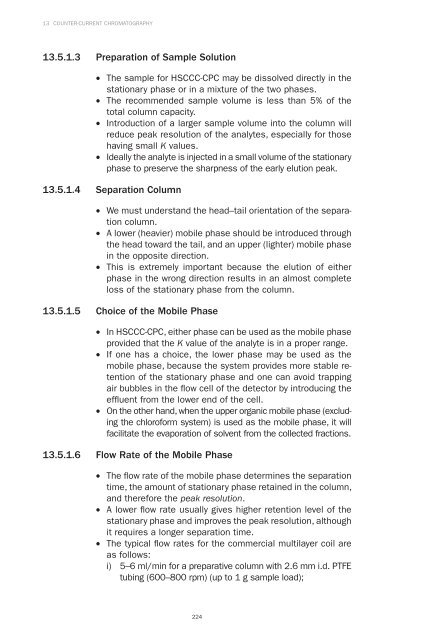Extraction Technologies For Medicinal And Aromatic Plants - Unido
Extraction Technologies For Medicinal And Aromatic Plants - Unido
Extraction Technologies For Medicinal And Aromatic Plants - Unido
Create successful ePaper yourself
Turn your PDF publications into a flip-book with our unique Google optimized e-Paper software.
13 COUNTER-CURRENT CHROMATOGRAPHY<br />
13.5.1.3 Preparation of Sample Solution<br />
• The sample for HSCCC-CPC may be dissolved directly in the<br />
stationary phase or in a mixture of the two phases.<br />
• The recommended sample volume is less than 5% of the<br />
total column capacity.<br />
• Introduction of a larger sample volume into the column will<br />
reduce peak resolution of the analytes, especially for those<br />
having small K values.<br />
• Ideally the analyte is injected in a small volume of the stationary<br />
phase to preserve the sharpness of the early elution peak.<br />
13.5.1.4 Separation Column<br />
• We must understand the head–tail orientation of the separation<br />
column.<br />
• A lower (heavier) mobile phase should be introduced through<br />
the head toward the tail, and an upper (lighter) mobile phase<br />
in the opposite direction.<br />
• This is extremely important because the elution of either<br />
phase in the wrong direction results in an almost complete<br />
loss of the stationary phase from the column.<br />
13.5.1.5 Choice of the Mobile Phase<br />
• In HSCCC-CPC, either phase can be used as the mobile phase<br />
provided that the K value of the analyte is in a proper range.<br />
• If one has a choice, the lower phase may be used as the<br />
mobile phase, because the system provides more stable retention<br />
of the stationary phase and one can avoid trapping<br />
air bubbles in the fl ow cell of the detector by introducing the<br />
effl uent from the lower end of the cell.<br />
• On the other hand, when the upper organic mobile phase (excluding<br />
the chloroform system) is used as the mobile phase, it will<br />
facilitate the evaporation of solvent from the collected fractions.<br />
13.5.1.6 Flow Rate of the Mobile Phase<br />
• The fl ow rate of the mobile phase determines the separation<br />
time, the amount of stationary phase retained in the column,<br />
and therefore the peak resolution.<br />
• A lower fl ow rate usually gives higher retention level of the<br />
stationary phase and improves the peak resolution, although<br />
it requires a longer separation time.<br />
• The typical fl ow rates for the commercial multilayer coil are<br />
as follows:<br />
i) 5–6 ml/min for a preparative column with 2.6 mm i.d. PTFE<br />
tubing (600–800 rpm) (up to 1 g sample load);<br />
224

















